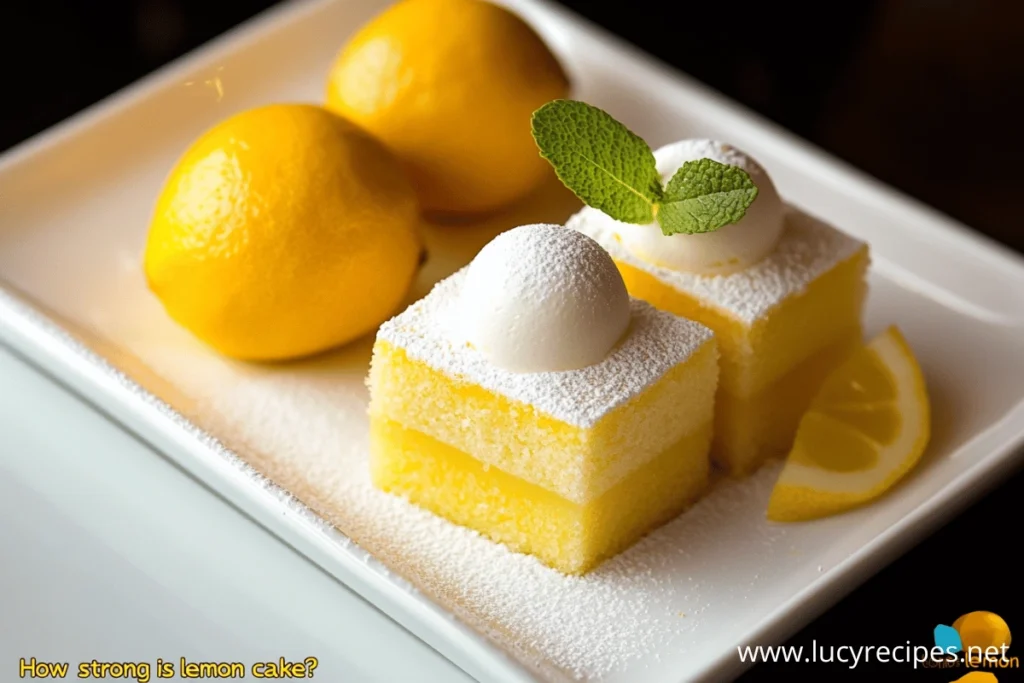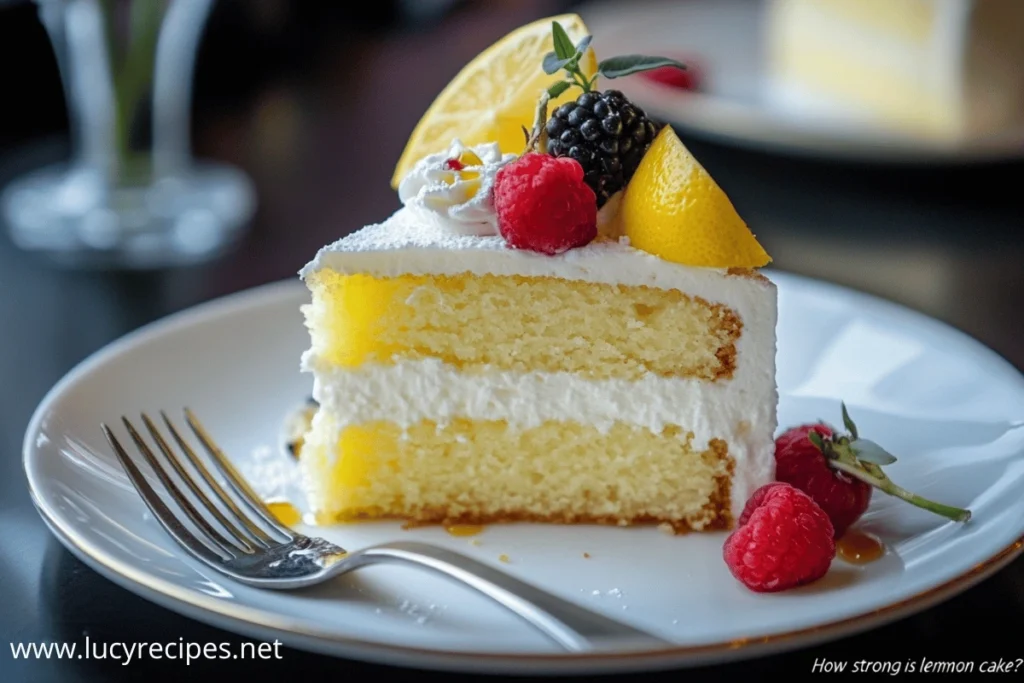Introduction
Lemon cake is a beloved dessert that has captured the hearts of many due to its refreshing flavor and soft, moist texture. Whether served as a light treat at tea time or as the centerpiece of a celebration, this versatile dessert continues to impress. But what makes lemon cake truly special? In this article, we’ll explore its origins, unique qualities, variations, and even the question, “How strong is lemon cake?” Join us as we delve into everything there is to know about this citrusy delight.
The Origins of Lemon Cake
Lemon cake’s history is as rich as its flavor. The origins trace back to ancient times when lemons were first cultivated in Southeast Asia. Over centuries, this tangy fruit spread to the Mediterranean and eventually became a key ingredient in European desserts.
- 16th century: Lemon desserts became popular among the European aristocracy.
- 18th century: Recipes for lemon-flavored cakes appeared in English cookbooks.
- Modern era: Lemon cake has evolved into various forms, from pound cakes to chiffon cakes.
This cultural blending of ingredients and techniques mirrors the adaptability seen in other baked goods, such as the lemon pound cake.
What Makes Lemon Cake Unique?
Lemon cake (or what we can also call Citrusy Cake) stands out among desserts due to its balance of flavors. The acidity of lemons cuts through the sweetness, creating a harmonious taste that’s both refreshing and indulgent.
Key Features That Define it:
- Citrus flavor: The zesty taste of lemons adds a natural brightness.
- Moist texture: Lemon juice and zest often enhance the cake’s moisture.
- Versatility: Citrusy Cake can be simple or extravagant, making it suitable for various occasions.
Unlike other desserts, Citrusy Cake appeals to those who prefer less sugary options, as the tartness complements the sweetness. This makes it a unique choice for those seeking a lighter yet flavorful treat.
How “Strong” is Lemon Cake?
The phrase “How strong is lemon cake?” can have different interpretations. Let’s break it down into its physical, nutritional, and flavor strengths.
Flavor Strength
Citrusy Cake’s flavor strength lies in its zesty tang. The use of lemon zest, juice, and sometimes lemon extract gives the cake its distinctive taste. The amount of lemon can be adjusted to make the flavor milder or more pronounced, depending on your preference.
For tips on achieving balanced flavors, consider techniques similar to those used in perfect bread stuffing.
Textural Strength
The cake’s structure is often reinforced by ingredients like eggs and butter. These create a stable yet tender crumb that holds up well to layering and frosting.
Nutritional Strength
Compared to richer desserts, lemon cake’s moderate sugar and fat content make it a relatively light indulgence. However, its strength is not in being a “health food” but in being a satisfying treat that doesn’t feel overly heavy.
Variations of Lemon Cake

Citrusy Cake comes in many delightful forms, each catering to different tastes and occasions. Here are some popular variations:
Classic Lemon Pound Cake
This dense and buttery cake is infused with lemon zest and juice, often topped with a sweet glaze. Its rich texture makes it a favorite for tea time.
Lemon Drizzle Cake
A lighter option, this cake is soaked with a tangy lemon syrup, creating a moist and flavorful dessert.
Lemon Chiffon Cake
Known for its airy texture, this cake combines lemon flavor with a sponge-like consistency, perfect for those who prefer something light and fluffy.
Vegan Lemon Cake
Using plant-based ingredients, this version offers the same zesty taste without eggs or dairy, appealing to a broader audience.
Lemon Cupcakes
These miniature cakes provide all the lemony goodness in a convenient, single-serving size, often topped with buttercream or cream cheese frosting.
Discover other versatile dessert ideas, like Earl Grey cookies, which also showcase unique flavor profiles.
Baking the Perfect Citrusy Cake
Creating the perfect Citrusy Cake requires attention to detail and the right balance of ingredients. Follow these tips for success:
Ingredients
- Fresh lemons: Always use fresh lemon juice and zest for the best flavor.
- Butter or oil: Choose high-quality fats to ensure a moist texture.
- Leavening agents: Baking powder or soda is essential for a light rise.
Techniques
- Creaming method: Beat butter and sugar until fluffy to incorporate air.
- Gentle mixing: Avoid overmixing to prevent a dense texture.
- Zest properly: Use a fine grater to extract zest without the bitter white pith.
Baking Tips
- Preheat your oven for even cooking.
- Use a toothpick to check doneness; it should come out clean when inserted into the center.
- Allow the cake to cool completely before applying frosting or glaze.
Learn how consistent baking methods are also pivotal in achieving results with butter biscuits.
The Nutritional Strength of Lemon Cake
Although Citrusy Cake is primarily a dessert, it does offer some nutritional benefits. Lemons themselves are rich in vitamin C, and using them in a recipe can add a hint of this essential nutrient.
Nutritional Highlights:
- Vitamin C: Supports immune health.
- Moderate calories: Suitable for occasional indulgence.
- Customizable: Substitute sugar or butter with healthier alternatives for a lighter version.
That said, moderation is key. Lemon cake’s true strength lies in its ability to bring joy and satisfaction without overwhelming indulgence.
Pairing with Other Foods

Pairing Citrusy Cake with complementary flavors can elevate its appeal. Here are some suggestions:
Beverages
- Tea: Earl Grey or chamomile enhances the citrus notes.
- Coffee: A robust espresso contrasts the cake’s tanginess.
- Sparkling water: A refreshing option for a light pairing.
Toppings and Sides
- Whipped cream: Adds a creamy texture.
- Fresh berries: Strawberries, raspberries, or blueberries enhance the citrus flavor.
- Ice cream: Vanilla or berry-flavored ice cream creates a delightful contrast.
Savory Pairings
- Cheese platter: Soft cheeses like mascarpone balance the tanginess.
- Nuts: Almonds or pistachios provide a satisfying crunch.
Lemon Cake Across Cultures
Citrusy Cake has a unique ability to transcend cultural boundaries, with variations and interpretations found across the globe. Each culture brings its own twist to this classic dessert, showcasing the versatility of lemons as a key ingredient.
Global Variations
- United States: Lemon pound cake is a staple, often served at family gatherings and coffee shops.
- United Kingdom: Lemon drizzle cake is a beloved teatime treat, known for its tangy glaze.
- Italy: Torta al limone incorporates lemon zest and olive oil, creating a light yet flavorful cake.
- France: French patisseries often feature lemon-infused sponge cakes layered with buttercream.
- Japan: Lemon-flavored castella cake highlights a spongy, honey-like texture.
This international appeal demonstrates how it resonates with diverse palates while adapting to local tastes and traditions.
Popular Recipes
The sheer variety of Citrusy Cake recipes is a testament to its enduring popularity. From classic versions to innovative twists, there’s a recipe for every occasion.
Classic Lemon Pound Cake
This dense cake features a blend of lemon zest and juice, creating a robust flavor. A glaze of powdered sugar and lemon juice adds the finishing touch.
Lemon Bundt Cake
A visually striking option, bundt cakes incorporate a moist batter infused with lemon. The intricate designs of the pan make it perfect for special occasions.
Gluten-Free Lemon Cake
This variation swaps traditional flour for almond or rice flour, making it accessible to those with dietary restrictions without sacrificing flavor.
Lemon Cheesecake Bars
These bars combine a buttery crust with a creamy lemon topping, ideal for serving at parties.
Lemon Ricotta Cake
This Italian-inspired cake uses ricotta cheese for a rich, moist texture, paired with the tangy brightness of lemons.
The Chemistry of Baking Lemon Cake
Understanding the science behind baking Citrusy Cake can help you achieve perfect results every time. Each ingredient plays a critical role in creating the desired texture and flavor.
The Role of Key Ingredients
- Lemons: The citric acid in lemons reacts with baking soda, creating carbon dioxide bubbles that help the cake rise.
- Eggs: Provide structure and moisture, ensuring a tender crumb.
- Butter and Sugar: When creamed together, these ingredients trap air, contributing to a light texture.
Balancing Acidity
Citrusy Cake’s tangy flavor comes from its acidity, which must be balanced with sweetness. Adjusting the ratio of sugar to lemon ensures the cake is neither too tart nor overly sweet.
Baking Temperature
A consistent oven temperature is essential for even baking. Too high, and the cake may brown prematurely; too low, and it may not set properly.
Seasonal Relevance

Lemon cake’s bright and zesty flavor makes it a versatile dessert suitable for various seasons. Its refreshing qualities make it particularly popular in spring and summer, but it can also bring a burst of sunshine to colder months.
Spring and Summer
- Pair with fresh berries: Enhance the seasonal appeal by adding strawberries or raspberries.
- Outdoor gatherings: Citrusy Cake is a favorite at picnics and garden parties due to its light flavor.
Fall and Winter
- Warm spices: Incorporate cinnamon or nutmeg to create a cozy twist.
- Holiday celebrations: A glazed lemon bundt cake can serve as an elegant centerpiece for festive tables.
Lemon Cake and Social Media Trends
Social media platforms have amplified the popularity of Citrusy Cake, with aesthetic presentations and creative recipes garnering attention worldwide. From food bloggers to amateur bakers, lemon cake continues to trend.
Viral Trends
- Drizzle shots: Videos showcasing lemon glaze being poured over cakes attract millions of views.
- Decorative styles: Floral and minimalist designs elevate lemon cake’s visual appeal.
- Quick recipes: Short tutorials on making Citrusy Cake in under an hour are highly shareable.
Engaging with Audiences
- Share behind-the-scenes baking processes.
- Use hashtags like #LemonCakeLovers or #ZestyTreats to increase visibility.
- Post interactive polls or Q&A sessions to connect with followers.
The Psychology of Citrus Flavors
The appeal of Citrusy Cake lies in the psychological effects of citrus flavors, which are often associated with refreshment and energy. Lemons evoke a sense of cleanliness and vitality, making them a popular choice for desserts.
Why Do People Love Lemon Cake?
- Refreshing flavor: The tanginess of lemons provides a palate-cleansing effect.
- Nostalgia: Many people associate Citrusy Cake with family traditions and happy memories.
- Mood enhancement: Citrus scents are known to uplift moods and reduce stress.
These psychological factors contribute to the universal appeal of lemon cake, making it a timeless dessert.
Lemon Cake in Literature and Media
Citrusy Cake has made its mark not only in kitchens but also in literature and media. Its symbolic qualities often represent comfort, home, or a touch of luxury.
Examples in Literature
- In classic novels, lemon desserts often signify opulence or special occasions.
- Lemon cake appears as a metaphor for life’s bittersweet moments in modern stories.
Appearances in Media
- Popular cooking shows frequently feature Citrusy Cake recipes, highlighting its versatility.
- Movies and TV shows often use Citrusy Cake as a prop to convey warmth or sophistication.
Sustainability in Lemon Cake Baking
Sustainability is becoming increasingly important in baking, and Citrusy Cake can be made with eco-friendly practices in mind.
Tips for Sustainable Baking
- Use locally sourced lemons: Reduces carbon footprint.
- Opt for organic ingredients: Ensures fewer pesticides and chemicals.
- Minimize waste: Repurpose lemon peels for zest or cleaning solutions.
Eco-Friendly Substitutions
- Replace butter with plant-based oils for a lower environmental impact.
- Use reusable baking pans and parchment paper alternatives.
Sustainable practices not only benefit the planet but also enhance the overall baking experience.
FAQs
How strong is lemon cake?
The strength of Citrusy Cake lies in its bold flavor, tender texture, and versatility. Its tanginess can be adjusted to suit individual preferences, making it a highly adaptable dessert.
Can lemon cake be made gluten-free?
Yes, substituting traditional flour with almond or rice flour creates a gluten-free version without compromising taste or texture.
What is the best way to store it?
Store Citrusy Cake in an airtight container at room temperature for up to three days, or refrigerate for longer freshness.
Conclusion:
Lemon cake’s enduring popularity stems from its versatility, refreshing flavor, and cultural significance. It has evolved across regions and eras, adapting to changing tastes and dietary preferences. Whether enjoyed as a simple tea cake or an elaborate layered creation, Citrusy Cake continues to captivate dessert lovers worldwide. Its ability to bring joy, nostalgia, and a burst of citrusy brightness ensures it will remain a timeless classic for generations to come.

